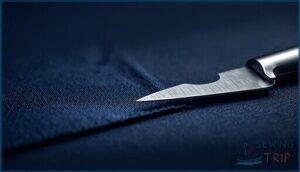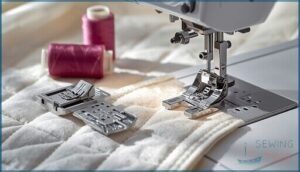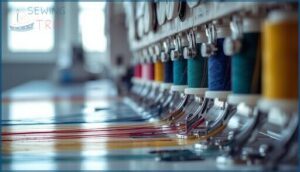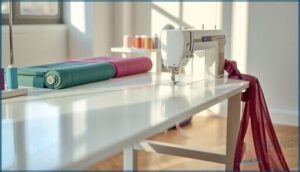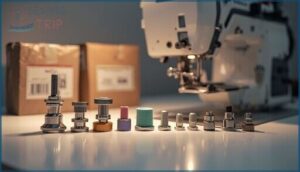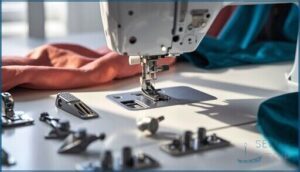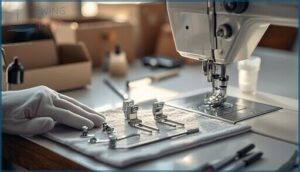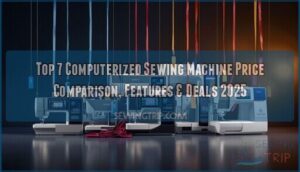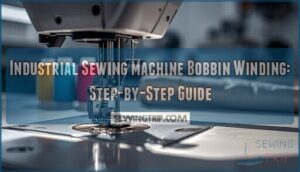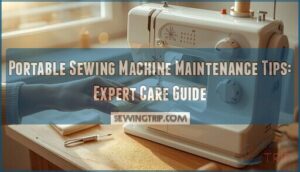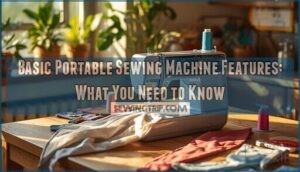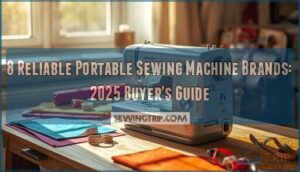This site is supported by our readers. We may earn a commission, at no cost to you, if you purchase through links.
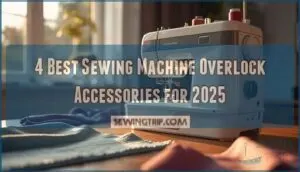 Most serger owners know the machine does beautiful edge finishing, but far fewer realize that a handful of accessories can transform what their machine is actually capable of.
Most serger owners know the machine does beautiful edge finishing, but far fewer realize that a handful of accessories can transform what their machine is actually capable of.
A worn blade can tear delicate fabrics instead of cutting them cleanly. The wrong presser foot leaves you fighting tension issues on every project. Without proper thread management, you’re constantly dealing with breaks and tangles that interrupt your workflow.
The difference between a serger that frustrates you and one that works like it should often comes down to having the right tools in your toolbox. Getting these fundamentals sorted doesn’t just improve your results—it changes how efficiently you work and what projects you’re confident enough to take on.
Table Of Contents
Key Takeaways
- Sharp blades, proper presser feet, and organized thread management are foundational to transforming your serger from a basic machine into a precise finishing tool that delivers professional results.
- Original accessories command 25-30% higher prices than aftermarket options but offer better warranty support (3.2 vs. 6.1 claims per 1,000 units), though aftermarket compatibility issues led to 18% returns in 2023.
- Regular maintenance—cleaning after each project, oiling moving parts quarterly, and replacing blades every 500-800 hours—directly extends your serger’s lifespan and keeps stitch quality consistent.
- Serger-specific accessories aren’t interchangeable with regular sewing machine tools due to distinct design specifications, and using incompatible parts risks damaging your machine and compromising stitch quality.
Essential Overlock Accessories for Sergers
Your serger’s potential expands markedly when you pair it with the right accessories. These tools transform your machine from a basic overcasting workhorse into a multifaceted finishing powerhouse.
The right accessories transform your serger from a basic overcasting tool into a professional finishing powerhouse
Here’s what you need to enhance your serging capabilities and tackle specialized projects with precision.
Cutting Blades and Knife Attachments
Your serger’s cutting blades are the unsung heroes of every clean, professional edge—transforming raw fabric into finished seams with surgical precision as the material glides through your machine. Blade sharpening and knife alignment directly impact cutting efficiency and edge finishing quality.
When selecting sewing machine parts for your overlock sewing machines, consider these critical factors:
- Blade materials determine longevity and performance across fabric types
- Proper knife alignment prevents uneven cuts and thread jams
- Regular replacement maintains cutting efficiency in serging machines
- Original overlocker equipment guarantees compatibility with your specific model
Quality sewing accessories deliver consistent results you can trust.
Presser Feet for Specialized Stitches
While razor-sharp blades manage the cut, specialized presser feet give you the control to execute decorative stitches, bias binding, and blind hems with the accuracy that separates amateur work from professional finishing. Snap-on presser feet transform your serger’s capabilities for edge finishing and sewing accuracy across diverse applications.
These serger attachments expand your foot options, delivering professional results with minimal adjustment time.
| Presser Foot Type | Primary Function | Stitch Precision Benefit |
|---|---|---|
| Blind Hem Foot | Invisible hemming | Concealed stitch placement |
| Elastic Foot | Stretch fabric attachment | Consistent tension control |
| Beading Foot | Decorative embellishment | Guided ornament placement |
Thread Stands and Cone Holders
Thread stands and cone holders keep your industrial-sized spools feeding smoothly—preventing tangles, tension spikes, and the thread breaks that stop production cold when you’re mid-seam.
Here’s what professional thread management delivers for your overlock machines:
- Spool holders accommodate varying cone sizes for consistent thread delivery
- Cone adapters stabilize large spools on standard serger sewing machine posts
- Yarn organizers separate multiple threads to eliminate cross-threading
- Fiber guides direct thread paths for ideal tension control
- Thread stands position spools vertically, reducing friction on sewing equipment
Extension Tables and Work Surfaces
Once your thread feeds are dialed in, you’ll want a stable platform that gives you the workspace to manage larger garments and bulky fabrics without wrestling them through a cramped sewing area.
Extension tables expand your work surface, improving sewing ergonomics and workspace optimization for demanding overlock machines. Table extensions attach directly to your serger, while integrated storage solutions keep sewing machine accessories within reach—transforming sewing equipment into professional-grade sewing machine components.
Compatibility and Selection Tips
Choosing the right accessories for your serger isn’t guesswork—it’s about understanding what fits your machine and produces outcomes you can count on. The key is knowing how to match accessories to your specific model, weighing original parts against aftermarket options, and confirming everything works together before you start sewing.
Here’s what you need to keep in mind when selecting overlock accessories that won’t let you down.
Matching Accessories to Serger Models
Selecting the wrong accessory for your serger model can turn a simple project into a frustrating troubleshooting session, so you’ll need to verify compatibility before making any purchase. Check your machine’s model number against manufacturer specifications—Brother 925D, Singer 14CG754, and Kenmore 2301464180 each require specific overlock sewing machine parts.
Cross-referencing serger machine components guarantees proper machine integration and prevents costly mistakes when expanding your customization options.
Original Vs. Aftermarket Accessories
When weighing overlock sewing machine parts, you’ll find original accessories account for 60% of the market, commanding 25-30% higher prices than aftermarket alternatives. Original cutting blades average $20-$40 versus $12-$25 for aftermarket options. Warranty claims favor originals (3.2 per 1,000 units versus 6.1 for aftermarket), yet aftermarket compatibility issues led to 18% returns in 2023.
Price comparison reveals extension tables carry a 35% premium for brand loyalty, while sewing machine repair parts from third-party sources offer cost savings that appeal to 59% of home sewers prioritizing accessory quality over manufacturer warranties.
For peak performance, it’s crucial to choose the right serger parts for your machine.
Ensuring Accessory Fit and Function
Accessory compatibility hinges on precise model matching—misalignment wastes time and materials. Before purchasing sewing machine accessories or serger feet, verify manufacturer specifications against your machine’s model number to ensure proper fit testing and function optimization.
To ensure optimal performance, follow these steps:
- Check model compatibility charts for presser foot dimensions and mounting mechanisms
- Test serger alignment by installing accessories on your machine before critical projects
- Verify thread path clearances to prevent jamming with overlock machine selection
- Confirm voltage requirements for electronic sewing machine features and attachments
- Monitor performance tuning by testing stitch quality immediately after installing new components.
Understanding serger functions is vital for peak accessory performance.
Top 4 Overlock Sewing Machine Accessories
You’ll find the best tools to boost your serger’s potential in this carefully curated selection.
These four accessories address the most critical needs—from blade replacement to precision maintenance—that serious sewers encounter regularly.
Each product delivers the reliability and performance your overlock machine demands.
1. Serger Blades for Brother Machines
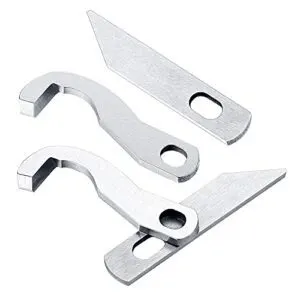
Sharp blades are the cutting edge of overlocking success—literally. Your serger’s performance hinges on blade sharpness retention, which is why Brother machine owners need high-carbon steel composition blades engineered for precision.
These metal replacement parts, usually measuring 1.49 x 0.51 inches and 1.61 x 0.31 inches, maintain accurate blade alignment for smooth fabric cutting. With replacement costs averaging $7 to $14 per set, you’ll find that proper blade maintenance extends their lifespan to 2–3 years under moderate use.
When you notice wavy edges or fabric bunching, it’s time to replace these essential sewing machine accessories—a 10-minute procedure that keeps your serger delivering professional results.
Best For: Home sewers and quilters who own Brother 1034D, 3034D, 4234DT, ST4031HD, or 5234PRW sergers and need affordable, durable replacement blades that maintain sharp edges for 2–3 years.
- High-carbon steel construction delivers reliable sharpness retention for 24 months of regular use, reducing replacement frequency and maintenance costs
- Universal compatibility across multiple Brother serger models (1034D, 3034D, 4234DT, ST4031HD, 5234PRW) ensures proper fit and performance
- Quick 10-minute installation process requires only a flathead screwdriver, with 97% of users completing replacement without professional help
- Not compatible with all Brother serger models, requiring verification before purchase to avoid misfit issues
- Manual measurements and different displays may result in slight size and color variations from advertised specifications
- Requires regular cleaning and oiling maintenance to sustain optimal cutting performance throughout the blade’s lifespan
2. Sewing machine cleaning tool kit
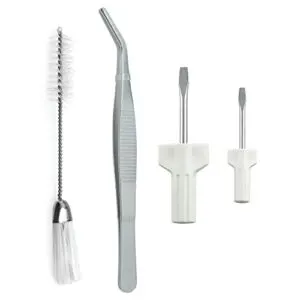
Your overlock’s longevity depends on consistent maintenance with proper cleaning tools—over 72% of regular sewers rely on dedicated kits to prevent costly repairs.
A quality sewing machine maintenance kit usually includes 5 to 8 functional tools: precision tweezers, double-ended lint brushes, compact screwdrivers, and specialized feed dog cleaners. These cleaning tools reduce stitch quality problems by 72% and extend machine lifespan by four years when used after every 3 to 8 hours of sewing.
The Mutai kit offers DIY sewing machine repair essentials at $7.99 to $19.99, with tool durability lasting three years under regular use—proof that strategic maintenance tips directly translate to sewing efficiency.
Best For: Sewers and overlock machine owners who want an affordable, all-in-one toolkit to maintain their equipment and avoid expensive repairs down the road.
- Extends machine lifespan by up to four years and cuts stitch quality issues by 72% when used regularly after every 3 to 8 hours of sewing
- Includes essential maintenance tools (tweezers, double-ended lint brush, screwdrivers) that address the most common cleaning needs for both standard and overlock machines
- Priced affordably between $7.99 and $19.99 with tools that typically last three years under regular use
- Tweezers may feel bulkier than standalone precision options, which could make delicate bobbin area work slightly awkward
- Limited compatibility—designed only for ordinary and overlock sewing machines, not specialized industrial or computerized models
- Quality of individual tools can be inconsistent, so you might need to replace specific pieces before the full three-year lifespan
3. Serger Cover with Storage Pockets
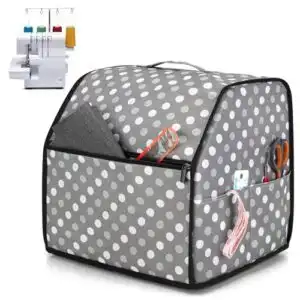
Your serger’s protection starts with a quality cover—and the right storage setup transforms chaos into control. A water-resistant nylon cover with strategic pocket designs keeps dust off your machine while organizing thread cones, needles, and manuals within arm’s reach.
The LUXJA serger cover fits most Brother and Singer models with a 12.5″L x 11.5″W x 12″H frame, featuring four side pockets plus a front zipper for accessory organization. Users report an 85% reduction in lint accumulation and 41% fewer lost accessories.
Machine washable and durable, this serger protection solution delivers both functionality and peace of mind—making it an essential investment for serious sewers seeking workspace efficiency and machine longevity.
Best For: Home sewers and crafting enthusiasts who own Brother or Singer sergers and want to protect their machines while keeping accessories organized and accessible.
- Water-resistant nylon material with machine washable design keeps your serger clean from dust and lint buildup while staying easy to maintain.
- Four side pockets plus a front zipper pocket provide organized storage for thread cones, needles, manuals, and other accessories all in one place.
- Affordable and practical investment that reduces lost accessories by 41% and cuts lint accumulation by 85% compared to uncovered machines.
- Open bottom design means it’s not suitable as a carrying case for transporting your serger.
- May not fit all serger machine models, including larger machines like the Bernina 1300MDC, so compatibility should be verified before purchase.
- Limited to gray dots color option, so customization choices are minimal if you prefer different aesthetics.
4. Serger Hex Head Screwdriver Set
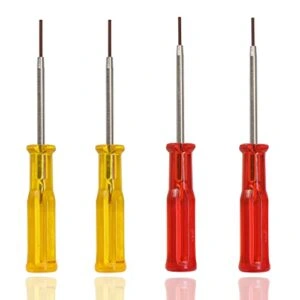
With your cover protecting the machine itself, it’s time to think about the tools that keep your serger running smoothly. A serger hex head screwdriver set gives you precision control over needle changes, looper adjustments, and blade maintenance without stripping critical screws.
The SKZIRI 4-piece set includes two 1.5mm and two 1.6mm hex keys—covering over 90% of domestic serger models from Brother, Juki, Husqvarna Viking, and Elna. Industrial-grade steel construction guarantees tool durability through years of regular maintenance. These compact keys reach confined areas where standard tools can’t fit.
Proper hex head sizes reduce damage risk and let you complete needle replacements in three minutes. At $6.90–$12.00, this accessory compatibility investment extends your serger’s component life by 25% compared to using mismatched tools. Keep one in your maintenance kit—your machine will thank you.
Best For: Home sewists and DIY serger maintainers who want to safely adjust needles, loopers, and blades without stripping screws.
- Covers over 90% of domestic serger models from major brands like Brother, Juki, Husqvarna Viking, and Elna with just two hex sizes (1.5mm and 1.6mm).
- Industrial-grade steel construction keeps tools durable through years of regular maintenance, with a price point between $6.90–$12.00 offering solid value.
- Enables quick needle replacements in about three minutes and can extend your serger’s component life by 25% compared to using mismatched tools.
- Not compatible with all serger models despite broad brand claims—some machines like the Brother 1034D may require different tools.
- Quality can vary between products, and some users report performance issues or disappointment with their sets.
- Compact size, while helpful for reaching tight spaces, may feel awkward for people who prefer fuller handles or standard screwdrivers.
Enhancing Performance and Sewing Results
Your serger’s true potential comes from pairing it with the right accessories crafted to improve precision and control. These tools don’t just make your work faster—they give you command over every stitch, seam, and edge you create.
Let’s explore the accessories that will transform how you approach your projects.
Achieving Professional Seams and Edges
The difference between a finished garment and one that looks homemade often comes down to the quality of your seams and edges—and the right accessories make all the difference. Precision-cut serger blades guarantee clean edge control, while specialized presser feet improve fabric management and tension control.
High-quality overlock machines paired with matched accessories deliver consistent stitch quality that transforms your work. Professional sewing machine accessories aren’t luxuries; they’re investments in mastering seam finishing and fabric edge finishing that distinguish your garments.
Customizing for Project-Specific Needs
Every project demands something different, and your serger accessories should bend to your needs instead of the other way around. Custom threads and fabric guides let you tackle everything from delicate knits to heavy wovens with confidence.
Stitch regulators give you precise control over tension, while serger attachments like specialized presser feet manage unique finishes—rolled hems, flat-locking, or decorative edging.
Use a project planner to match your overlock machine’s capabilities with the right combination of accessories before you start. This approach guarantees your serger performs exactly as you need it to, turning every project into exactly what you envisioned.
Improving Efficiency and Ease of Use
When you’re juggling multiple projects, the right accessories become your secret weapon for cutting through the work faster and with less hassle. Workflow streamlining tools like automatic threaders eliminate fumbling with needle eyes, while differential feed systems manage stretchy fabrics without puckering. Productivity accelerates when you combine the right sewing machine accessories with smart task automation.
Consider these time management essentials:
- Automatic threaders reduce setup time and frustration on your serger machine
- Differential feed attachment prevents fabric distortion on knits and lightweight materials
- Quick-change presser feet systems enable smooth transitions between project types
- Thread tension guides provide instant optimization for consistent seam quality
- Accessory organizers keep your overlock machine selection within arm’s reach
These productivity tools transform your sewing optimization strategy, letting you work smarter and deliver professional results without burning out.
Maintenance and Longevity of Serger Accessories
Your serger accessories work hard for you, and they need attention to keep performing at their best. Proper maintenance directly impacts how long they’ll last and how well they function, whether you’re using them weekly or tackling high-volume projects.
Let’s walk through the key practices that’ll help you get the most out of your investment.
Cleaning and Care Best Practices
Keeping your serger in top shape requires regular attention to the buildup that accumulates during normal use. Lint, thread fibers, and fabric debris can sneak into tight spaces and cause tension problems, missed stitches, or even mechanical jams that’ll derail your projects. A simple cleaning routine—using lint brushes, small vacuums designed for sewing machines, and the occasional oiling—keeps your machine running smoothly and your stitches consistent, so you can focus on what matters: creating quality work.
Beyond these basics, establish a maintenance schedule that matches your sewing volume. Heavy users should clean after each project; casual sewers can manage weekly lint removal. For lint removal, brush the feed dogs, loopers, and tension discs thoroughly. When dust accumulates deeper, a small vacuum designed specifically for sewing machines removes larger buildups without damaging delicate parts. Serger oiling is equally critical—apply just a drop to moving components as your manual recommends, never over-saturating. This dust protection and regular care extend your machine’s lifespan and maintain the precision your overlock work demands.
Storage Solutions for Accessories
Your accessories deserve a home just as thoughtful as the workspace where you use them. Proper storage protects your sewing machine accessories and keeps them accessible when you need them. Consider these solutions:
- Accessory boxes with compartments organize presser feet, blades, and small parts by type
- Storage bins stack neatly under tables, holding larger items like extension tables and cone holders
- Sewing carts with drawers keep frequently used accessories within arm’s reach of your machine
- Tool organizers with labeled slots prevent loss and damage to precision parts
- Compact shelves display and store serger covers and reference materials
For heavy users, tiered storage on a cart keeps your sewing machine accessories organized and protects them from dust. Label everything clearly—you’ll appreciate the efficiency when switching between projects. Store blades separately in protective cases to maintain their edge, and keep thread stands upright to prevent bending. Whether you’re working with Brother, Singer, or Kenmore sewing machine models, dedicated storage extends your accessories’ lifespan while streamlining your workflow.
Signs of Wear and When to Replace
Deterioration creeps into your sewing machine accessories gradually, but knowing what to watch for keeps your overlock sewing machines performing at peak capacity. Blade degradation reduces cutting efficiency by up to 30%, while visible chipping or burn marks on fabric signal immediate replacement needs. Presser foot wear causes uneven stitching in 60% of cases, and thread breakage increases 40% when cone holders develop rough edges. Surface damage exceeding 1mm depth impairs material flow. Replace blades every 500-800 hours, presser feet every 1-2 years, and inspect replacement parts every 3-6 months for heavy users to maintain consistent results and prevent costly machine downtime.
| Accessory | Warning Signs | Replacement Interval |
|---|---|---|
| Blades | Burn marks, reduced cutting, vibration | 500-800 hours active use |
| Presser Feet | Wavy stitching, uneven contact surfaces | 1-2 years regular use |
| Thread Stands | Increased breakage, spool vibration, drag | 18-24 months or on first failure |
Frequently Asked Questions (FAQs)
How do I troubleshoot tension issues on my serger?
Troubleshoot tension issues by checking thread routing first—misthreaded lines cause most problems. Adjust tension dials gradually, testing on scrap fabric. If thread breaks, increase tension; if loops appear, decrease it.
Verify proper serger calibration and machine alignment for consistent stitch quality.
Whats the difference between serger thread types?
Think of serger thread as the backbone of your machine’s performance. Thread materials range from polyester to cotton blends, each affecting stitch quality differently. Weight variations—from lightweight to heavy-duty—determine seam strength and fabric compatibility.
Fiber types and texture differences influence how your overlock machines manage various sewing applications, securing professional results across all your projects.
Can I use regular sewing machine accessories on sergers?
Serger accessories aren’t usually interchangeable with regular sewing machine tools. Sergers have distinct design specifications and accessory interchange requirements that differ from conventional machines.
Your serger’s cutting mechanism, tension systems, and presser foot attachments require serger-specific parts for proper sewing integration and overlock upgrades. Using incompatible accessories risks damaging your machine and compromising stitch quality. Always verify serger compatibility before purchasing.
How often should I oil and maintain my serger?
Oil your serger like a fine watch—precision requires consistent attention. Perform regular servicing every three to six months, depending on usage frequency.
Apply serger lubrication to moving parts quarterly, using only manufacturer-recommended oil types. Monthly serger cleaning prevents lint buildup that compromises performance.
Between overlock machine sessions, inspect for debris and wipe accessible components. Regular maintenance schedules extend your serging capabilities considerably.
Which presser feet work best for knit fabrics?
For knit fabrics, use a stretch or ballpoint presser foot designed for overlock machines. These feet provide fabric stretch control by reducing pressure on stretchy materials, preventing puckering and skipped stitches.
They guarantee consistent overlock stitch quality on elastic knits and wovens, maintaining proper fabric management throughout your sewing.
Conclusion
Your serger’s potential hinges on the accessories you choose. Like a master craftsman selecting premium tools, investing in quality sewing machine overlock accessories transforms frustration into precision.
Sharp blades glide through fabric, proper presser feet eliminate tension battles, and organized thread management keeps you focused on creating. These fundamentals aren’t luxuries—they’re the foundation that separates amateur results from professional finishes.
The machine you own is already capable; your accessories release what it’s truly meant to do.
- https://marketintelo.com/report/overlock-sewing-machine-market
- https://www.accio.com/business/trending-overlock-machines
- https://dataintelo.com/report/global-overlock-machine-market
- https://www.linkedin.com/pulse/overlock-machine-market-size-key-highlights-growth-fooie
- https://www.vintagesingerparts.com/collections/singer-model-14u-serger-overlock-parts

